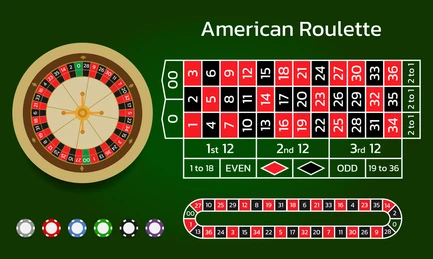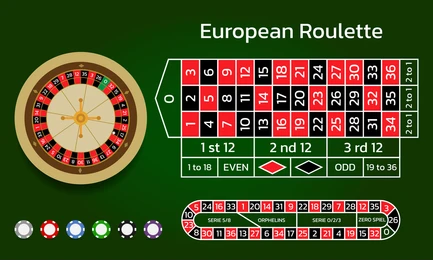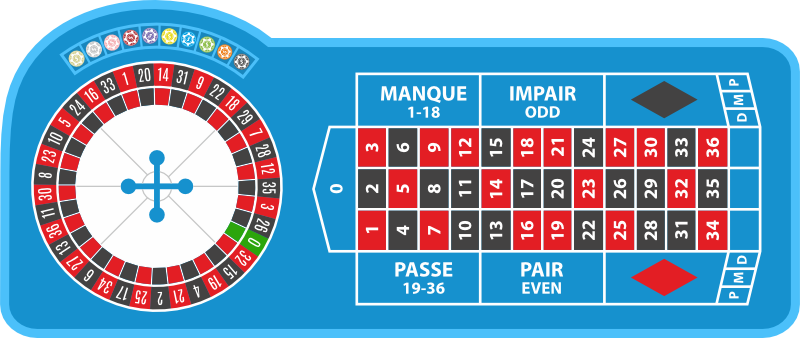Roulette is a classic casino game that has been captivating players for centuries. The game has evolved over the years, with European, American, and French versions emerging as the most popular variations. Each version offers its unique features, rules, and betting options, making it essential for players to understand the differences before diving into the world of online roulette. Today we will explore the distinctions between European, American, and French roulette, highlighting the nuances that can impact a player’s experience and success at online casinos.
General Differences Between the Roulette Variations
The Origins of Roulette Variations
Before discussing the differences between the three variations, it’s essential to understand their origins. Roulette is believed to have originated in France in the 18th century. The original version of the game featured numbers from 1 to 36 and a single zero (0), which later came to be known as European roulette. As the game spread across Europe and reached the United States, an additional double zero (00) was added to the wheel, creating what we now know as American roulette. Finally, the French version of the game evolved in France, retaining the single zero layout but introducing a unique set of rules that distinguish it from its European counterpart.
Wheel and Number Layout
One of the most apparent differences between European, American, and French roulette lies in the wheel and number layout. The European and French wheels feature 37 pockets, with numbers 1-36 and a single zero (0). In contrast, the American wheel has 38 pockets, including an extra double zero (00). The additional double zero pocket in American roulette increases the house edge, making it less favorable for players compared to European and French roulette.
House Edge
The house edge is a critical factor that determines the odds of winning and the potential payouts in roulette. In European roulette, the house edge is 2.70%, while American roulette has a significantly higher house edge of 5.26%. This increased house edge is due to the presence of the double zero pocket. French roulette, on the other hand, offers the same 2.70% house edge as European roulette but introduces additional rules that can further reduce the house advantage in specific situations.
Betting Options and Payouts
The betting options in European, American, and French roulette are quite similar, with players having the choice to place inside bets, outside bets, and announced bets. However, the presence of the double zero pocket in American roulette affects the odds and payouts for certain bets. For example, a straight-up bet on a single number in American roulette pays 35 to 1, while the odds of winning the bet are 1 in 38. In European and French roulette, the same bet pays 35 to 1, but the odds of winning are 1 in 37.
The Unique Rules of French Roulette
While European and American roulette rules are relatively straightforward, French roulette introduces two unique rules that set it apart: “La Partage” and “En Prison.” The La Partage rule applies to even-money outside bets (red/black, even/odd, high/low). If the ball lands on zero, players lose only half their bet instead of the entire amount. This effectively reduces the house edge on even-money bets to 1.35%.
The En Prison rule is another option that can further reduce the house edge in French roulette. When the ball lands on zero, players can choose to “imprison” their even-money bet for the next spin. If the bet wins on the next spin, the original stake is returned to the player without any winnings.
American roulette
 American roulette, a popular casino game with a rich history, has captured the attention and imagination of gamblers worldwide. This captivating game of chance, characterized by its spinning wheel and ivory ball, has become a symbol of glamour and intrigue. Although it shares similarities with its European counterpart, American roulette has unique features that set it apart.
American roulette, a popular casino game with a rich history, has captured the attention and imagination of gamblers worldwide. This captivating game of chance, characterized by its spinning wheel and ivory ball, has become a symbol of glamour and intrigue. Although it shares similarities with its European counterpart, American roulette has unique features that set it apart.
History of American Roulette
American roulette has its roots in 18th-century France when a primitive version of the game was introduced by French settlers in America. This early form of roulette had a wheel with 28 numbered pockets, a zero, a double zero, and an American eagle symbol, which functioned as an additional house pocket. The American eagle soon disappeared, but the double zero pocket remained, creating the distinctive layout still found in modern American roulette wheels.
As the game evolved, the wheel design was standardized, and roulette tables were introduced in casinos throughout the United States, particularly in the gambling meccas of Las Vegas and Atlantic City. Today, American roulette is enjoyed by millions of players worldwide, both in land-based casinos and online platforms.
The Roulette Wheel and Table Layout
At the heart of American roulette is the iconic wheel, which features 38 numbered pockets: 1-36, a single zero (0), and a double zero (00). The numbers are not placed in numerical order and alternate between red and black colors, with the zero and double zero pockets colored green. The wheel is meticulously designed to ensure a random outcome for each spin.
The roulette table displays a corresponding layout with numbered sections for placing bets. In addition to the numbered grid, the table includes additional betting areas for even-money and group bets. The layout is designed to facilitate various types of wagers, offering players a wide range of betting options.
Rules and Betting Options
The objective of American roulette is to predict the pocket in which the ball will land after the wheel is spun. Players place their bets on the table before the croupier spins the wheel and releases the ball. Once the ball settles into a pocket, the croupier announces the winning number and pays out any successful bets.
There are numerous betting options in American roulette, which can be categorized into two main types: inside bets and outside bets.
- Inside bets: These wagers are placed directly on the numbered grid and include:
- Straight-up: A bet on a single number, paying 35:1.
- Split: A bet on two adjacent numbers, paying 17:1.
- Street: A bet on three numbers in a horizontal row, paying 11:1.
- Corner: A bet on four numbers sharing a corner, paying 8:1.
- Five-number: A bet on 0, 00, 1, 2, and 3, paying 6:1.
- Six-line: A bet on six numbers in two adjacent rows, paying 5:1.
- Outside bets: These wagers are placed on the additional betting areas surrounding the numbered grid and include:
- Column: A bet on 12 numbers in a vertical column, paying 2:1.
- Dozen: A bet on a group of 12 numbers (1-12, 13-24, or 25-36), paying 2:1.
- Even-money bets: Wagers on Red/Black, Even/Odd, or High (19-36)/Low (1-18) numbers, paying 1:1.
European Roulette
 European Roulette has its roots in 17th-century France, where mathematician and philosopher Blaise Pascal inadvertently invented the roulette wheel. Originally, Pascal was attempting to create a perpetual motion machine, but the spinning wheel he designed eventually evolved into the game we know today. The roulette wheel has undergone several transformations, with the most significant change occurring in the mid-19th century when the modern European Roulette wheel with a single zero was introduced by François and Louis Blanc.
European Roulette has its roots in 17th-century France, where mathematician and philosopher Blaise Pascal inadvertently invented the roulette wheel. Originally, Pascal was attempting to create a perpetual motion machine, but the spinning wheel he designed eventually evolved into the game we know today. The roulette wheel has undergone several transformations, with the most significant change occurring in the mid-19th century when the modern European Roulette wheel with a single zero was introduced by François and Louis Blanc.
The Basics of European Roulette
The Roulette Wheel
The European Roulette wheel consists of 37 numbered pockets, with numbers ranging from 0 to 36. The pockets alternate between red and black, with the exception of the single green pocket numbered 0. The numbers on the wheel are arranged in a seemingly random order, but they are carefully designed to maintain a balance between red and black, odd and even, and high and low numbers.
The Roulette Table
The roulette table layout features a betting area where players can place their bets on various options. The table is divided into two main sections: the inside betting area and the outside betting area. The inside betting area contains the individual numbers, while the outside betting area features grouped bets such as red or black, odd or even, and high or low.
Rules of European Roulette
Placing Bets
Before the dealer spins the roulette wheel, players place their bets on the table. Bets can be placed on individual numbers, groups of numbers, or other options such as red or black, odd or even, and high or low. Each bet has a specific payout based on the probability of the outcome.
The Spin
Once all bets have been placed, the dealer spins the roulette wheel in one direction and releases the small white ball in the opposite direction. As the wheel slows down, the ball will eventually come to rest in one of the numbered pockets.
Determining the Outcome
The dealer announces the winning number, and players with winning bets receive their payouts. All losing bets are collected by the dealer, and a new round begins.
Types of Bets in European Roulette
Inside Bets
These bets involve wagering on specific numbers or small groups of numbers. They offer higher payouts but have lower probabilities of winning. Examples of inside bets include:
- Straight-Up: Betting on a single number.
- Split: Betting on two adjacent numbers.
- Street: Betting on three numbers in a horizontal row.
- Corner: Betting on four numbers that form a square.
- Six Line: Betting on six numbers that form two adjacent rows.
Outside Bets
These bets involve wagering on larger groups of numbers or specific outcomes. They offer lower payouts but have higher probabilities of winning. Examples of outside bets include:
- Red or Black: Betting on whether the winning number will be red or black.
- Odd or Even: Betting on whether the winning number will be odd or even.
- High or Low: Betting on whether the winning number will be between 1-18 (low) or 19-36 (high).
- Dozen: Betting on a group of 12 numbers (1-12, 13-24, or 25-36).
French Roulette
 French roulette, a captivating and sophisticated casino game, has captured the attention of gamblers across the globe for centuries. With its origins in 18th century France, this elegant game of chance has become a staple in casinos and has evolved into a symbol of luxury and glamour. But what sets French roulette apart from its American and European counterparts?
French roulette, a captivating and sophisticated casino game, has captured the attention of gamblers across the globe for centuries. With its origins in 18th century France, this elegant game of chance has become a staple in casinos and has evolved into a symbol of luxury and glamour. But what sets French roulette apart from its American and European counterparts?
The History of French Roulette
French roulette, as the name suggests, was developed in France during the late 18th century. The game’s creation is attributed to French mathematician Blaise Pascal, who inadvertently developed the mechanism for roulette while attempting to invent a perpetual motion machine. French roulette quickly gained popularity in France and later spread throughout Europe, where it was embraced by gambling enthusiasts.
The French Roulette Table
The French roulette table is similar to the European roulette table, with a few key distinctions. The wheel features numbers 0-36, with alternating red and black pockets, while the zero pocket is green. The layout of the betting area is also different, with the numbers arranged in three columns and 12 rows. The unique feature of the French roulette table is the racetrack-shaped betting area, where players can place call bets such as Voisins du Zéro, Tiers du Cylindre, and Orphelins.
French Roulette Rules
The core gameplay of French roulette is similar to other versions of the game. Players place bets on the outcome of the spin, which is determined by a small ball landing in one of the numbered pockets on the wheel. There are several types of bets, including inside bets, outside bets, and call bets.
Inside bets are placed directly on individual numbers or small groups of numbers, while outside bets are placed on larger groups of numbers, such as red or black, odd or even, or high or low. Call bets, which are unique to French roulette, involve betting on specific sections of the wheel.
The En Prison and La Partage Rules
French roulette boasts two advantageous rules that set it apart from other versions of the game: En Prison and La Partage. These rules come into play when the ball lands on zero, and they offer players an opportunity to recover some or all of their initial bet.
En Prison allows players to “imprison” their bet for the next spin if the ball lands on zero. If the player’s bet wins on the following spin, they recover their original bet; if it loses, the entire bet is forfeited. La Partage, on the other hand, allows players to recover half of their even-money bets (such as red/black, odd/even, or high/low) if the ball lands on zero.
French Roulette Strategies
Like all roulette variants, French roulette is predominantly a game of chance. However, there are strategies that players can employ to increase their chances of winning or at least minimize their losses. Popular strategies include the Martingale, Fibonacci, and D’Alembert systems. These strategies are based on adjusting bet sizes according to previous outcomes, aiming to either recover losses or capitalize on winning streaks.
Summary
The differences between European, American, and French roulette at online casinos can be considered both subtle and significant, as they offer unique game experiences and require distinct strategies. As we have delved into the nuances of each variant, it becomes clear that understanding these differences is essential for players who want to maximize their chances of success and enjoyment when engaging with these games.
The European version, considered the original and most popular variant, is characterized by its straightforward and simplistic design. With 37 pockets, a single zero, and a house edge of 2.7%, it provides players with reasonable odds of winning, while still maintaining the excitement that is inherent to the game of roulette. This variant serves as a solid starting point for beginners, who can then progress to the other versions with greater confidence and understanding.
American roulette, on the other hand, is known for its higher house edge of 5.26%, primarily due to the inclusion of the double zero pocket. This additional pocket increases the difficulty for players, but also provides an element of challenge that may appeal to experienced gamblers looking for a more demanding experience. However, it is important to acknowledge that this increased house edge may not be suitable for all players, particularly those who prioritize winning over the thrill of the game.
French roulette is often seen as the most player-friendly of the three variants, due to its unique rules – La Partage and En Prison – which can reduce the house edge to as low as 1.35% when making even-money bets. While these rules may seem complex at first, they ultimately provide a level of strategic depth that can be highly rewarding for those willing to invest the time and effort into mastering them. The elegant, historic atmosphere associated with French roulette also adds to its appeal, offering a sophisticated gaming experience that stands out from the other variants.
In the realm of online casinos, the accessibility and convenience of these different roulette versions have been further enhanced. With numerous platforms offering a variety of roulette games, players have the opportunity to explore and experiment with each version to discover their personal preferences and hone their skills. Additionally, online casinos provide a wealth of resources, tutorials, and strategies to help players make informed decisions about which variant to play, as well as how to employ effective betting strategies and bankroll management techniques.
Ultimately, the choice between European, American, and French roulette will depend on an individual’s personal taste, risk appetite, and desired level of challenge. For players seeking a balanced experience with a modest house edge, European roulette may be the preferred option. Those who enjoy a higher level of difficulty and risk may gravitate towards American roulette, while the strategic and historic appeal of French roulette may captivate players looking for a more sophisticated and potentially rewarding experience.
In the ever-evolving landscape of online gambling, it is crucial for players to remain informed and adaptable, recognizing the unique characteristics and challenges of each roulette variant. By doing so, they can make the most of their gambling experience and increase their chances of success, while also enjoying the rich history and captivating excitement that has made roulette one of the most enduring and popular casino games of all time.
